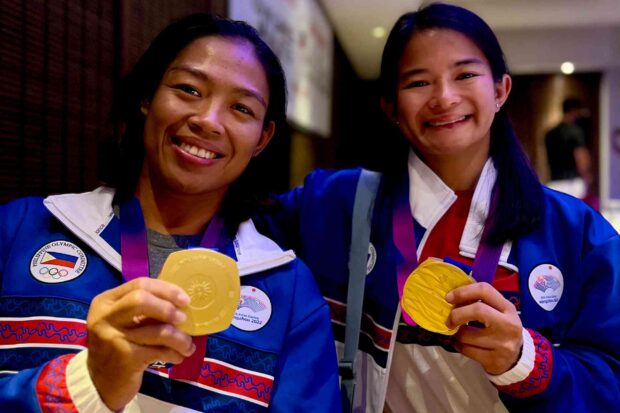
Annie Ramirez (left) and Meggie Ochoa produced half of Team Philippines’ golden haul in the Asian Games. —FRANCIS T. J. OCHOA
As Tim Cone and the men’s basketball team kicked off its dramatic run to the Asian Games (Asiad) gold medal in Hangzhou, China, two Filipino athletes were literally fighting their way to continental glory in the background.
The timing was a perfect metaphor for jiujitsu and its place in the country’s mainstream sporting consciousness.
“Education,” said Annie Ramirez, who won the gold medal in the women’s 57-kilogram division of the Japanese form of martial arts, when asked what it will take to shine light on jiujitsu’s remarkable run of success for the country.
Her teammate, Meggie Ochoa, agreed.
“Definitely, education,” said Ochoa, who bagged the -48kg women’s gold. “Jiujitsu is not an easy sport to understand.”
The Asian Games could have been the most visible platform for Ramirez, Ochoa and their sport.
But the timing of their schedules was not conducive for a coming-out party.
Ochoa won her gold medal first, downing Balqees Abdulla of the United Arab Emirates a day after the men’s basketball team forged a dramatic 77-76 semifinal victory over Asian rival China. Ochoa tearfully leapt into her coach’s arms and held the headlines briefly as the Filipinos’ win over Team Dragon dominated Asiad discussion.
A day later, Ramirez screamed in delight as she held off Kazakhstan’s Galina Duvanova for her gold. Later that night, Team Philippines won the basketball gold with a 70-60 victory over Jordan.
‘Personal struggles’
But neither rued the timing of their triumphs. In fact, the thoughts ran through their mind after clinching gold were about something else entirely.
“We had personal struggles that’s why you saw we were very emotional in the finals. I was eliminated in [the] 2018 [Asian Games] so all these emotions were coming from somewhere,” Ramirez said. “Personal, training, financial [problems] … were part of the journey and I was just happy to get past all that.”
For Ochoa, the internal crisis was magnified by the troubles she encountered in Hangzhou. “I went through a lot [in my] personal life in 2023, at the start of the year, and then I was injured in the SEA Games, I couldn’t train for a long time … [and] I couldn’t join the world championship,” she said.
Then, two days before the competition started, Ochoa caught the flu. In the morning of her first match, she received a call before 7 a.m. informing her of a change in her fight schedule. She had to leave in 20 minutes to make it to the arena in time for her first match.
“So I couldn’t do my morning routine. I usually read the Bible and I couldn’t do that. I couldn’t eat well,” Ochoa said.
She pulled a quad muscle in her semifinal win and had to fight the final in pain. To alleviate that pain, she had to play to Abdulla’s strengths.
“I knew she is at her strongest when she is under her opponent. But I had no choice. I had to stay on top,” Ochoa said, adding that playing underneath sent currents of pain in her leg.
“I won by one advantage,” she said, holding up one finger for emphasis. “It was that close.”
Ramirez, 32, and Ochoa, 33, are hoping that their victories will keep their sport in the limelight and translate into more support.
Grassroots project
“There’s been a lot of improvement. Maybe our results in international competitions helped that,” Ramirez said. “I guess it’s just maintain that support or level it up.”
“Like, for example, our grassroots program. We need to cover all the bases and we need to organize more efforts … to widen jiujitsu’s growth in the country,” Ochoa added.
Jiu-Jitsu Federation of the Philippines Inc. president Ferdie Agustin revealed the national federation is planning a project with the Philippine Sports Commission that would boost the sport’s grassroots program. He added that the international federation, meanwhile, is working to give the sport its most visible platform: The Olympics.
“Maybe 2028 is a long shot, but definitely, we have a chance in 2032,” he said.
For now, the sport lives and breathes through the likes of Ramirez, Ochoa and Asiad bronze medalist Kaila Napolis, who won the gold in the Southeast Asian (SEA) Games.
Jiujitsu is also a big part of mixed martial arts (MMA), but it hasn’t matched the popularity spurt of MMA.“I still get asked when I tell people I’m a jiujitsu athlete, ‘Is that like karate?’” Ramirez said.
“Sure, MMA helps a little. But we still need to educate people more about the sport, that it’s a rich medal source for Filipinos,” she added. “Sometimes, it feels sad that after all our effort, it’s still like ‘oh, you guys exist?’”
Ochoa hopes those questions would end someday, what with a growing number of young practitioners waiting in the wings for their shot at glory.
“There’s a lot of young athletes now taking up the sport,” she said.
When their time comes, maybe they can finally have the limelight all to themselves. INQ